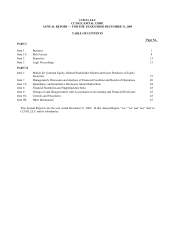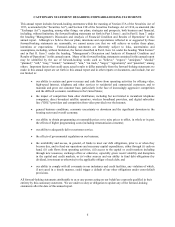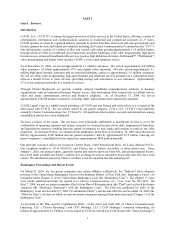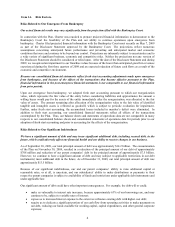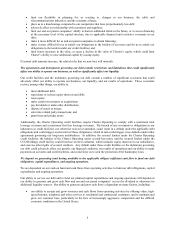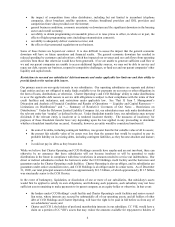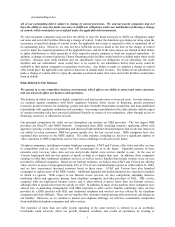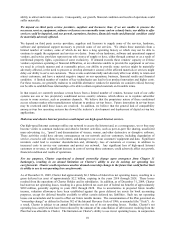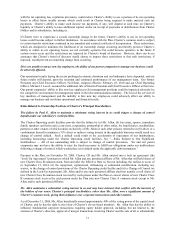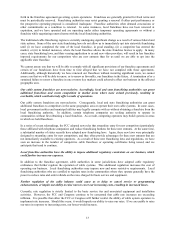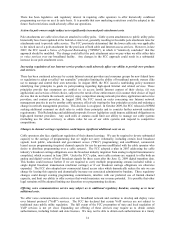Charter 2009 Annual Report Download - page 10
Download and view the complete annual report
Please find page 10 of the 2009 Charter annual report below. You can navigate through the pages in the report by either clicking on the pages listed below, or by using the keyword search tool below to find specific information within the annual report.7
our outstanding notes.
All of our outstanding debt is subject to change of control provisions. We and our parent companies may not
have the ability to raise the funds necessary to fulfill our obligations under our indebtedness following a change
of control, which would place us in default under the applicable debt instruments.
We and our parent companies may not have the ability to raise the funds necessary to fulfill our obligations under
our notes and our credit facilities following a change of control. Under the indentures governing our notes, upon the
occurrence of specified change of control events, the applicable note issuer is required to offer to repurchase all of
its outstanding notes. However, we may not have sufficient access to funds at the time of the change of control
event to make the required repurchase of the applicable notes, and all of the notes issuers are limited in their ability
to make distributions or other payments to their respective parent company to fund any required repurchase. In
addition, a change of control under the Charter Operating credit facilities would result in a default under those credit
facilities. Because such credit facilities and our subsidiaries’ notes are obligations of our subsidiary, the credit
facilities and our subsidiaries’ notes would have to be repaid by our subsidiaries before their assets could be
available to their parent companies to repurchase their notes. Any failure to make or complete a change of control
offer would place the applicable note issuer or borrower in default under its notes. The failure of our subsidiaries to
make a change of control offer or repay the amounts accelerated under their notes and credit facilities would place
them in default.
Risks Related to Our Business
We operate in a very competitive business environment, which affects our ability to attract and retain customers
and can adversely affect our business and operations.
The industry in which we operate is highly competitive and has become more so in recent years. In some instances,
we compete against companies with fewer regulatory burdens, better access to financing, greater personnel
resources, greater resources for marketing, greater and more favorable brand name recognition, and long-established
relationships with regulatory authorities and customers. Increasing consolidation in the cable industry and the repeal
of certain ownership rules have provided additional benefits to certain of our competitors, either through access to
financing, resources, or efficiencies of scale.
Our principal competitors for video services throughout our territory are DBS providers. The two largest DBS
providers are DirecTV and DISH Network. Competition from DBS, including intensive marketing efforts with
aggressive pricing, exclusive programming and increased high definition broadcasting has had an adverse impact on
our ability to retain customers. DBS has grown rapidly over the last several years. DBS companies have also
expanded their activities in the MDU market. The cable industry, including us, has lost a significant number of
video customers to DBS competition, and we face serious challenges in this area in the future.
Telephone companies, including two major telephone companies, AT&T and Verizon, offer video and other services
in competition with us, and we expect they will increasingly do so in the future. Upgraded portions of these
networks carry two-way video, data services and provide digital voice services similar to ours. In the case of
Verizon, high-speed data services operate at speeds as high as or higher than ours. In addition, these companies
continue to offer their traditional telephone services, as well as service bundles that include wireless voice services
provided by affiliated companies. Based on our internal estimates, we believe that AT&T and Verizon are offering
video services in areas serving approximately 26% to 31% of our estimated homes passed as of December 31, 2009,
and we have experienced increased customer losses in these areas. AT&T and Verizon have also launched
campaigns to capture more of the MDU market. Additional upgrades and product launches are expected in markets
in which we operate. With respect to our Internet access services, we face competition, including intensive
marketing efforts and aggressive pricing, from telephone companies and other providers of DSL. DSL service
competes with our high-speed Internet service and is often offered at prices lower than our Internet services,
although often at speeds lower than the speeds we offer. In addition, in many of our markets, these companies have
entered into co-marketing arrangements with DBS providers to offer service bundles combining video services
provided by a DBS provider with DSL and traditional telephone and wireless services offered by the telephone
companies and their affiliates. These service bundles offer customers similar pricing and convenience advantages as
our bundles. Moreover, as we continue to market our telephone offerings, we will face considerable competition
from established telephone companies and other carriers.
The existence of more than one cable system operating in the same territory is referred to as an overbuild.
Overbuilds could adversely affect our growth, financial condition, and results of operations, by creating or


